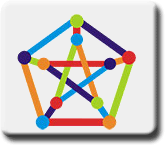|
 The
basic structure of our logo is what is known as a graph. The
basic structure of our logo is what is known as a graph.
A graph
has a set of vertices (points), some pairs of which are joined by
an edge (line). The particular graph we are using is known as the
Petersen graph after the 19th century Danish mathematician, Julius
Petersen.
Assigning colours to the vertices of a graph in such
a way that no two vertices that are joined by an edge have the same
colour is known as a proper colouring of the vertices. Assigning
colours to the edges of a graph in such a way that no two edges
that meet at a vertex have the same colour is known as a proper
colouring of the edges. A total colouring of a graph is one in which
not only do we have a proper colouring of both the vertices and
edges but also we have that no vertex and edge of the same colour
are incident.
Our logo is totally coloured in five colours; you
might try to see if four colours is sufficient. In general it is
an unsolved problem as to how few colours we must use to totally
colour a graph. If the degree of a vertex is the number of edges
incident with it, then it is easy to see that we need at least the
size of the largest degree + 1 colours for a total colouring. It
is conjectured that we can always get by with at most the the size
of the largest degree + 2 colours.
Graph colouring problems in general deal with the
fundamental problem of partitioning sets of objects into classes
according to certain rules. These problems have applications in
such areas as time tabling and scheduling.
| 
